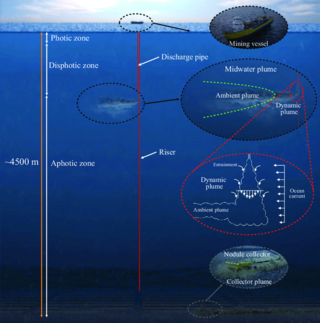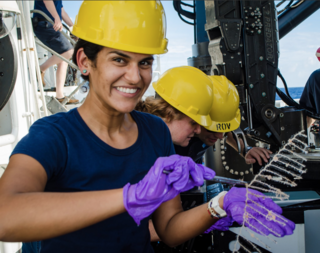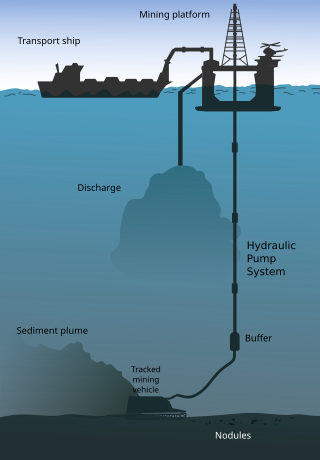
The International Seabed Authority (ISA) is a Kingston, Jamaica-based intergovernmental body of 167 member states and the European Union established under the 1982 UN Convention on the Law of the Sea (UNCLOS) and its 1994 Agreement on Implementation. The ISA's dual mission is to authorize and control development of mineral related operations in the international seabed considered the "common heritage of all mankind" and also protect the ecosystem of the seabed, ocean floor and subsoil in "The Area" beyond national jurisdiction. The ISA is to safeguard the international deep sea, the waters below 200 meters or 656 feet, where photosynthesis is hampered by inadequate light. Governing approximately half of the total area of the world's oceans, the ISA is to exercise oversight of activities that might threaten biological diversity and harm the marine environment. The Authority operates as an autonomous international organization with its own Assembly, Council and Secretariat.

Polymetallic nodules, also called manganese nodules, are mineral concretions on the sea bottom formed of concentric layers of iron and manganese hydroxides around a core. As nodules can be found in vast quantities, and contain valuable metals, deposits have been identified as a potential economic interest. Depending on their composition and autorial choice, they may also be called ferromanganese or polymetallic nodules. Ferromanganese nodules are mineral concretions composed of silicates and insoluble iron and manganese oxides that form on the ocean seafloor and terrestrial soils. The formation mechanism involves a series of redox oscillations driven by both abiotic and biotic processes. As a byproduct of pedogenesis, the specific composition of a ferromanganese nodule depends on the composition of the surrounding soil. The formation mechanisms and composition of the nodules allow for couplings with biogeochemical cycles beyond iron and manganese. The high relative abundance of nickel, copper, manganese, and other rare metals in nodules has increased interest in their use as a mining resource.

Xenophyophorea is a clade of foraminiferans. Members of this class are multinucleate unicellular organisms found on the ocean floor throughout the world's oceans, at depths of 500 to 10,600 metres. They are a kind of foraminiferan that extract minerals from their surroundings and use them to form an exoskeleton known as a test.

An abyssal plain is an underwater plain on the deep ocean floor, usually found at depths between 3,000 and 6,000 metres. Lying generally between the foot of a continental rise and a mid-ocean ridge, abyssal plains cover more than 50% of the Earth's surface. They are among the flattest, smoothest, and least explored regions on Earth. Abyssal plains are key geologic elements of oceanic basins.

The seabed is the bottom of the ocean. All floors of the ocean are known as 'seabeds'.
The Komokiacea are a small group of amoeboid protozoa, considered to be foraminifera, though there have been suggestions that they are a separate group, closely related to foraminifera. Komokiacea are rather large organisms, often exceeding 300 micrometers in maximum dimensions. Along with Xenophyophores they dominate the macro- and megabenthic fauna in the deep sea and are commonly referred to as "giants protists".

Deep sea mining is the extraction of minerals from the ocean floor found at depths of 200 metres (660 ft) to 6,500 metres (21,300 ft). As of 2021, the majority of marine mining efforts were limited to shallow coastal waters, where sand, tin and diamonds are more readily accessible. It is a growing subfield of experimental seabed mining. Three types of deep sea mining have generated interest: polymetallic nodule mining, polymetallic sulfide mining, and cobalt-rich ferromanganese crusts. The majority of proposed deep sea mining sites are near polymetallic nodules or active and extinct hydrothermal vents at 1,400 to 3,700 metres depth. The vents create globular or "massive" sulfide deposits that contain valuable metals such as silver, gold, copper, manganese, cobalt, and zinc. The deposits are mined using hydraulic pumps or bucket systems that carry ore to the surface for processing.
Nii Allotey Odunton, a mining engineer from Ghana, was the Secretary-General of the International Seabed Authority, serving back to back four-year terms starting in 2009 and ending in 2017. He was succeeded by Michael W. Lodge.

Antje Boetius is a German marine biologist. She is a professor of geomicrobiology at the Max Planck Institute for Marine Microbiology, University of Bremen. Boetius received the Gottfried Wilhelm Leibniz Prize in March 2009 for her study of sea bed microorganisms that affect the global climate. She is also the director of Germany's polar research hub, the Alfred Wegener Institute.
Trophomera marionensis is a deep-sea nematode endoparasite of the family Benthimermithidae. They can be found in one of the deepest parts of the ocean, for example, in the hadal zone 7,000 to 10,000 meters below sea level. They exist in relentless darkness under immense water pressure. Marine invertebrates are their definitive hosts. They infest a wide range of invertebrate marine hosts: polychaete, priapulids, crustaceans, and even other nematodes. Death of their host can result if they occupy the entire body, at which point they exit and reproduce.

Diva Joan Amon is a marine biologist from Trinidad. She is currently a post-doctoral researcher in the Benioff Ocean Initiative at the University of California, Santa Barbara and a 2022 Pew Marine Fellow. Previously, she was a Marie Skłodowska-Curie Actions (MSCA) Research Fellow at the Natural History Museum, London.
Pacificitalea manganoxidans is a Gram-negative, strictly aerobic, manganese-oxidizing and non-motile bacterium from the genus Pacificitalea which has been isolated from sediments of the Pacific Clarion-Clipperton Fracture Zone in China.
Lisa A. Levin is a Distinguished Professor of biological oceanography and marine ecology at the Scripps Institution of Oceanography. She holds the Elizabeth Hamman and Morgan Dene Oliver Chair in Marine Biodiversity and Conservation Science. She studies coastal and deep-sea ecosystems and is a Fellow of the American Association for the Advancement of Science.
Deep Ocean mission is an Indian initiative to undertake the deep ocean exploration focused on India's exclusive economic zones and continental shelf. The program will consist of various crewed and uncrewed submersibles exploring the sea bed. One of the primary aims of the mission is to explore and extract polymetallic nodules, which are composed of minerals like manganese, nickel, cobalt, copper and iron hydroxide. The metals can used in the manufacturing of electronic devices, smartphones, batteries and solar panels.

Occultammina is a genus of xenophyophorean foraminifera known from the Atlantic and Pacific oceans. It is notable for being the first known infaunal xenophyophore as well as for being a possible identity for the enigmatic trace fossil Paleodictyon.

Benthodytes is a genus of sea cucumbers in the family Psychropotidae.

Seabed mining, also known as Seafloor mining is the recovery of minerals from the seabed by techniques of underwater mining. The concept includes mining at shallow depths on the continental shelf and deep-sea mining at greater depths associated with tectonic activity, hydrothermal vents and the abyssal plains. The increased requirement for minerals and metals used in the technology sector has led to a renewed interest in the mining of seabed mineral resources, including massive polymetallic sulfide deposits around hydrothermal vents, cobalt-rich crusts on the sides of seamounts and fields of manganese nodules on the abyssal plains. Whilst the seabed provides a high concentration of valuable minerals there is an unknown risk of ecological damage on marine species because of a lack of data.

Bolosoma is a genus of pedunculated siliceous sponges belonging to the family Euplectellidae. This genus lives in deep-sea environments and provides a habitat for a plethora of other benthic species, giving Bolosoma an incredibly important ecological role in the ecosystems it is a part of.

Namibia is one of the first countries that issued mining licences regarding deep sea mining. studies that took place in 1970s discovered considerable amounts of phosphate deposits. The significance of seabed mining in Namibia's blue economy is highlighted by the country's status as a "phosphate factory". This is due to the exceptional upwellings of the Benguela Current ecosystem, a transboundary ocean current that spans from South Africa in the south to Angola in the north, passing through Namibia. Those deposits were found in depths between 180 and 300 meters below the sea level. In 2011 the Namibian government issued licences regarding the exploitation of the seabed phosphate resources after the necessary Environmental Impact Assessments (EIAs). The action plan that stood out was that of Namibian Marine Phosphates (NMP), a joint venture formed in 2008 between two Australian-based companies, Minemakers and Union Resources and Namibian-based Tungeni Investments. The so-called Sandpiper phosphate mining project outlay was introduced in January 2012 along with environmental reports regarding the effect this operation would have on marine life as well as the fishing industry and water quality changes. Those phosphorite resources are being found in continental shelves and slopes in America, Northern Spain, Morocco, Namibia, and South Africa which show a high potential for exploration.
On the 25th of June 2021, the president of Nauru, Lionel Aingimea, made a formal request to the president of the International Seabed Authority's (ISA) council to complete the adoption of rules, regulations and procedures necessary to facilitate the approval of plans of work for exploitation of deep-sea resources in the Area. This request is based on the "2-year rule", which is part of a provision from the 1994 Agreement relating to the Implementation of Part XI of the United Nations Convention on the Law of the Sea. The provision can be found in section 1 of the annex, and it states that the ISA must complete the adoption of rules, regulations and procedures for the approval of the exploitation of deep-sea minerals within 2 years of the request. The ISA's current deadline for drafting new regulation is set in July 2023, although some claim that this is not a "hard" or "fixed" deadline. Due to the issue's complexity, negotiations have thus far failed to come to a concrete agreement. Even if it fails to set clear standards for deep-sea mining activities, the ISA must consider applications for exploitation in waters outside national jurisdictions and provisionally approve contracts after July 2023. Many experts fear that deep-sea mining activities that are not adequately regulated could significantly impact the marine environment, the economies of many nations and the livelihoods of indigenous groups who depend on the oceans for survival.
















